Saturday Sep 13, 2025
Saturday Sep 13, 2025
Friday, 3 September 2021 00:00 - - {{hitsCtrl.values.hits}}

 The Ceylon Electricity Board (CEB) is identified as one of the most strategically important and largest State-owned enterprises (SOE) in Sri Lanka. However, it is currently also amongst the highest loss-making SOEs in the country, creating a significant burden on the public finances of the country.
The Ceylon Electricity Board (CEB) is identified as one of the most strategically important and largest State-owned enterprises (SOE) in Sri Lanka. However, it is currently also amongst the highest loss-making SOEs in the country, creating a significant burden on the public finances of the country.
Over a period of 10 years, from 2010 to 2019, the CEB had accumulated a total loss of over Rs. 246 billion. This is likely to further increase in 2020, as there was an additional loss of over Rs. 62 billion incurred during the year.
The cost of generating power varies considerably based on the power source. The given infographic (Figure 1) illustrates the unit cost of generating power in 2020 from the key power plants that generate over 50 Gigawatt Hours (Gwh) of power annually. The figures show that the unit cost of generating power from hydropower plants is the lowest compared to other sources of power generation in Sri Lanka.
Over the last 10 years, on average, 66.9% of CEB’s total costs can be attributed to the cost of power generation. The magnitude of the contribution to total electricity generated by source of power can significantly influence the profitability of the CEB. As hydropower incurs the least cost of generating power, there is a positive relationship between the extent of hydropower contribution to electricity and the CEB’s profitability.
As seen in the infographic (Figure 2), over the last 10 years, the CEB was reported to have recorded a profit in only 2013 and 2015 respectively. Evidently, it was also in these same years that the share of hydropower generation to electricity peaked at 58% and 46% respectively.